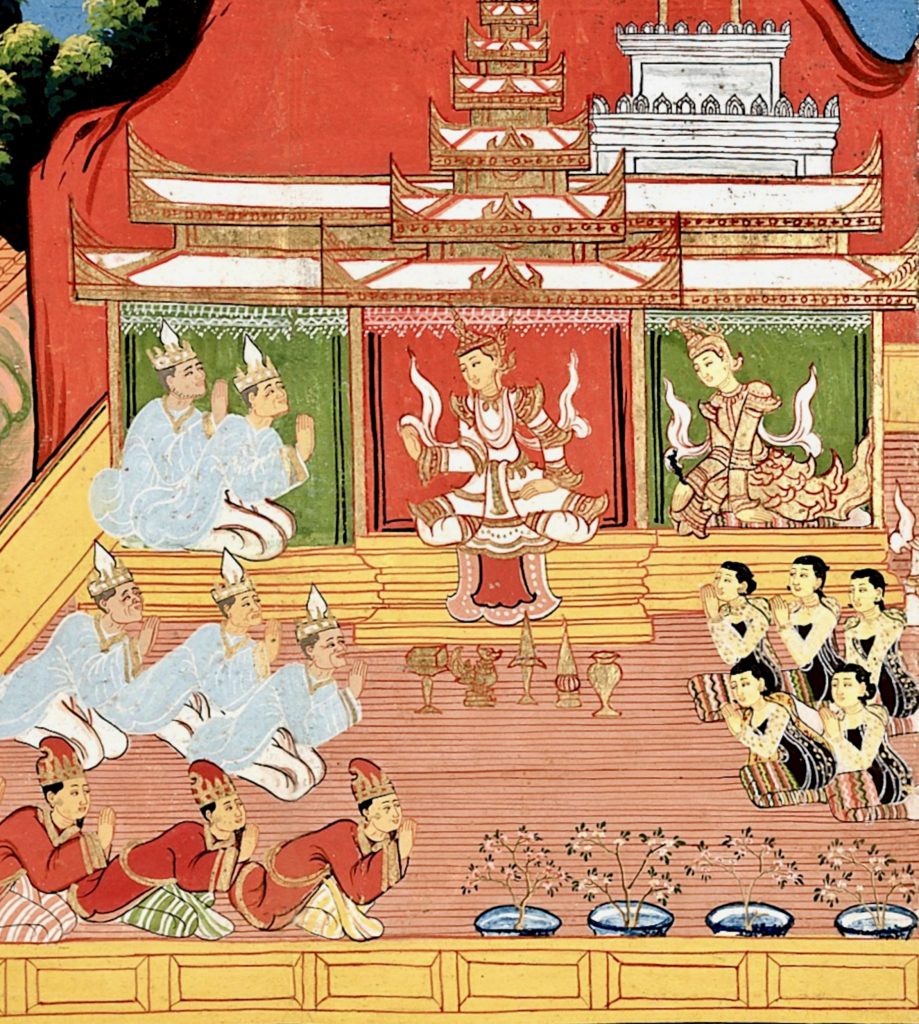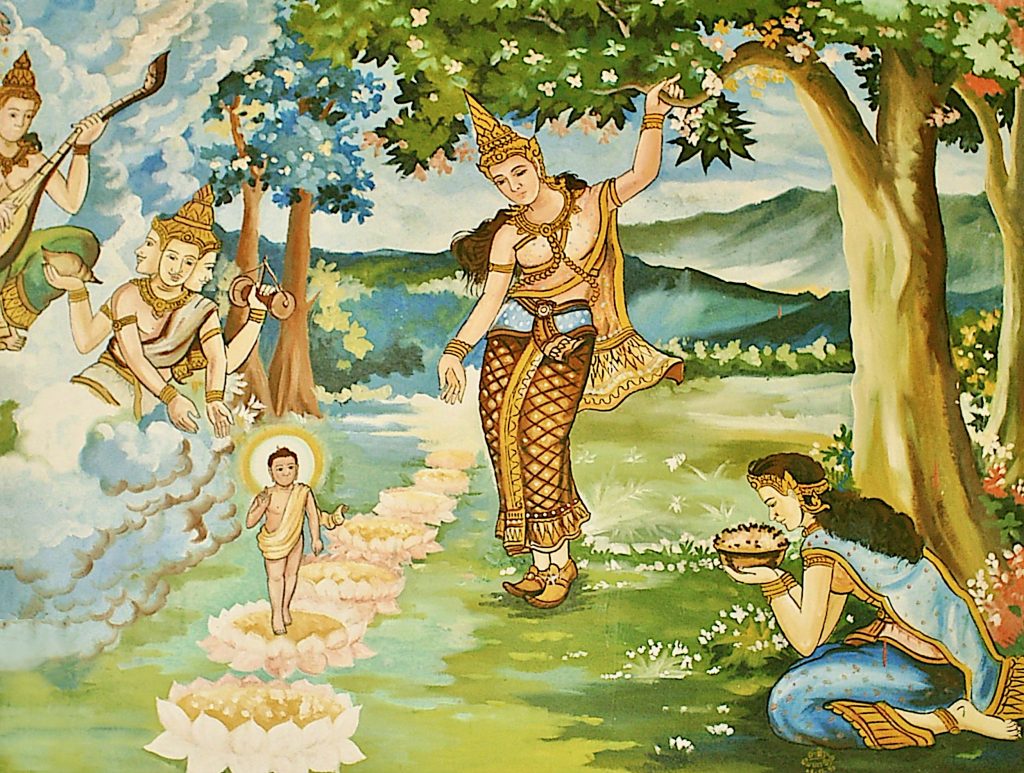From Long Ago
A curriculum for middle elementary grades by Dan Harper, v. 2.0
Copyright (c) 2014-2024 Dan Harper
The Birth of Buddha
Once upon a time, the people of the city of Kapilavatthu were celebrating a spring festival, and the queen of the city, Queen Maya, celebrated with them. One day, she arose early, gave money to many beggars, ate a delicious meal, and then went back to the palace to sleep.
As she slept, she dreamed that the four Guardian Angels of the world lifted her up and took her to the highest mountains in the Himalayas. They set her down under a huge Sala tree. Four more angels came forth, clothed Queen Maya in heavenly garments, and led her to a silver mountain. Inside the silver mountain was a house of gold, and there the queen lay down to rest. It was not long before a great and gentle white elephant came into the silver mountain, carrying a white lotus flower in his trunk. This pure white elephant trumpeted, walked around the bed where the queen lay, and gave her the lotus flower.

When the queen awakened the next morning, she told her dream to her husband, King Suddhodana. The king called sixty-four wise brahmins. After serving them food in gold and silver bowls, the king told them the dream and asked them what it meant. The brahmins told the king, “Do not worry, great king. This dream means that Queen Maya will soon give birth to a baby boy. If this child chooses life at home he will become the greatest king the world has seen; but if instead he chooses to forsake home life and become a hermit, then he will become a great religious teacher.”

Creative Commons Attribution 4.0 International by Wellcome Collection; image cropped and edited for clarity.
When it came time for Queen Maya to give birth, she told King Suddhodana that she wanted to go to the city where her parents were the king and queen. King Suddhodana called a thousand officers to carry the queen and escort her on the journey. Along the way was a beautiful place called Lumbini Park, and at that time of year the trees were covered with blossoms, and flocks of singing birds flew among the flowers. The queen asked to stop to enjoy the beauty. She got down from the palanquin, and as she reached up to grasp a blossom of a Sala tree, she knew it was time for her to have her baby. The officers set up a curtain around her for privacy. As she stood there holding the branch of the Sala tree, the queen gave birth.
Immediately, the four great Brahmas appeared with a fine golden net, and they carefully laid the new baby into this net. Presenting the child to Queen Maya, they said, “Be joyful, O Queen, for you have given birth to a child of greatness.” The four Brahmas prepared a soft antelope skin, and placed the child on it. The baby stood up and looked towards the east. Voices were heard saying, “O Great One, there is no other like you!” The baby gazed in all directions, and then took seven steps towards the north, while the Great Brahma held a white umbrella over him.

Creative Commons Attribution-Share Alike 3.0 Unported license, photo by Sacca~commonswiki. Image has been cropped and edited for clarity.
Queen Maya brought the baby home. The king rejoiced to see his new son, and they named their baby Siddhartha Gautama. Now a hermit who lived nearby, a man with great spiritual wisdom, heard about this new baby. He came down to the palace and said to King Suddhodana, “O King, I have heard that you and the queen have had a child, and I would like to see him.” They brought the child out, and upon seeing him the hermit knew the baby would grow up to be a great man, and he stood and paid homage to the baby. Then the hermit smiled, and proclaimed that the baby would become the Buddha when he was thirty-five years old.
And that is exactly what happened. Although King Suddhodana tried to convince his son to become a king, when Siddhartha Gautama was old enough to decide what to do with his life, he left the palace and went out into the world. He got his food by begging, and he went to learn from the greatest spiritual teachers. At last, he sat down beneath a tree to meditate, and he achieved enlightenment, and became the Buddha, the Enlightened One, the one who awakened to the Truth of the ages. Buddha spent the rest of his life teaching others how they, too, could calm themselves and awaken to the truth.
Source: Adapted from The Story of Gotama Buddha: Jataka-nidana, translated from original Pali texts by N. A. Jayawickrama (Oxford: Pali Text Society, 1990, 2002), pp. 66-72.
Session Six: The Birth of Buddha
I/ Opening
Take attendance.
Light chalice with these words and the associated hand motions: “We light this chalice to celebrate Unitarian Universalism: the church of the open mind, the helping hands, and the loving heart.”
Check-in: Go around circle. Each child and adult says his or her name, and then may say one good thing and one bad thing that has happened in the past week (anyone may pass).
II/ Read the story
Read the story above.
III/ Act out the story
This week’s story is just as much fun to act out as last week’s story!
As usual, begin by asking: “Who are the characters in this story?” The many characters include: Buddha’s mother (Queen Maya of Sakya), Buddha’s father (King Suddhodana), the elephant, the Guardian Angels of the world, etc.
Determine where the stage area will be, and the lead teachers sits facing the stage. As usual, the lead teacher reads the story, prompting actors as needed to act out their parts. Depending on the size of the class, some children make take on more than one role.
Once again, it would be great to take photos, print them out later, and post them on the bulletin board in your classroom.
IV/ Conversation about the story
Sit back down in a group. Go over the story to make sure the children understand it.
Now ask some general questions: “What was the best part of the story? Who was your favorite character? Who was your least favorite character?” — or questions you come up with on your own.
Ask some questions specific to the story: “How does is this story like the Christmas story of the birth of Jesus?” “And how is this story like the story of the birth of Confucius?” Finally: “How true is this story — really true, sort of true, mostly made up but feels true, or what?”
I like to tell children that while this story isn’t really true, there is truth in it. Just like Confucius and Jesus, Buddha was one of the greatest people who ever lived, and so we like to imagine that there must have been miracles that happened when he was born. And, if you think about it, any time a child is born, it feels like a miracle!
V/ Drawing pictures and having snack
This is a great story for drawing pictures. You might try asking the children to draw separate episodes from the story. You could start by making a list of the episodes, which might look something like this:
- Queen Maya dreaming
- The Guardian Angels take her to the Himalaya Mountains
- Four more angels lead her into the palace of gold
- The white elephant brings her a flower
- The king asks the sixty-four brahmins
- The queen stops in Lumbini park, and gives birth
- Four great Brahmas lay the baby in a gold net
- The baby takes seven steps
- The hermit asks to see the baby
When they are done, you can place the drawings on your classroom bulletin board in the order each scene appears in the story. Or you could make a book out of the drawings. If the children want to take their drawings home, try to take photos of the drawings so you can have a record of them.
VI/ Play
Ideas for free play: “Duck, Duck, Goose”; play with Legos; if weather is warm enough you might want to go outside and run around; etc.
VII/ Closing circle
Before leaving, have the children stand in a circle.
When the children are in a circle, ask them what they did today, and prompt them with questions and answers, e.g.: “What did we do today? We heard a story, right? Anyone remember what the story was about? It was about the miraculous birth of Buddha, which is like the stories about the miraculous births of Confucius and Jesus.” You’re not trying to put any one child on the spot, but rather drawing on the wisdom of the group as a whole. If any parents have come to pick up their children, invite them to join the circle (so they can know what it is their children learned about this week).
Say the closing words together — either these words, or others you choose:
Go out into the world in peace,
Be of good courage,
Hold fast to what is good,
Return to no one evil for evil.
Strengthen the fainthearted
Help the suffering;
Be patient with all,
Love all living beings.
Then tell the children how you enjoyed seeing them, and that you look forward to seeing them again next week.